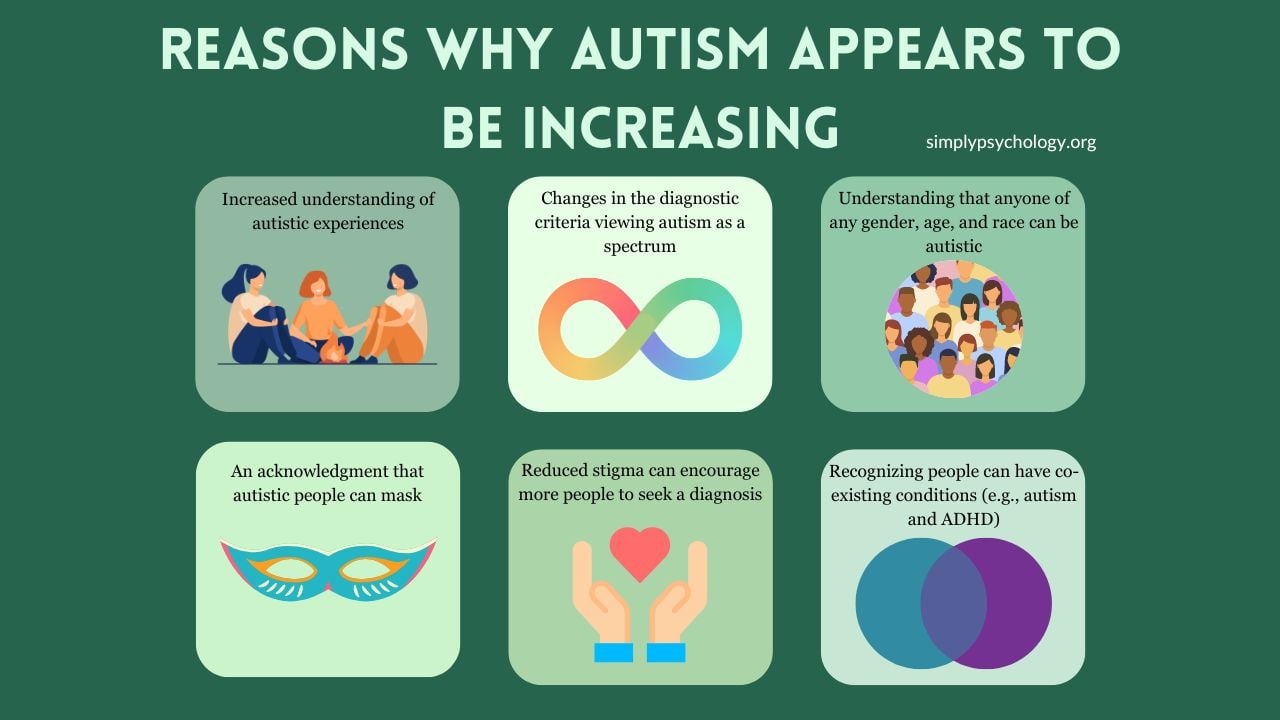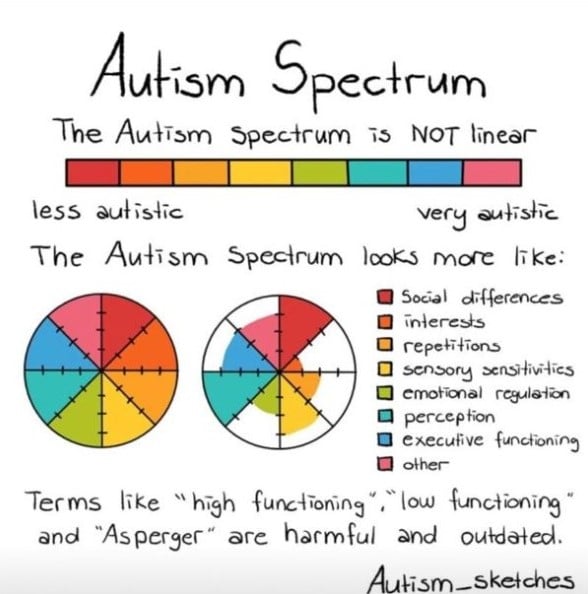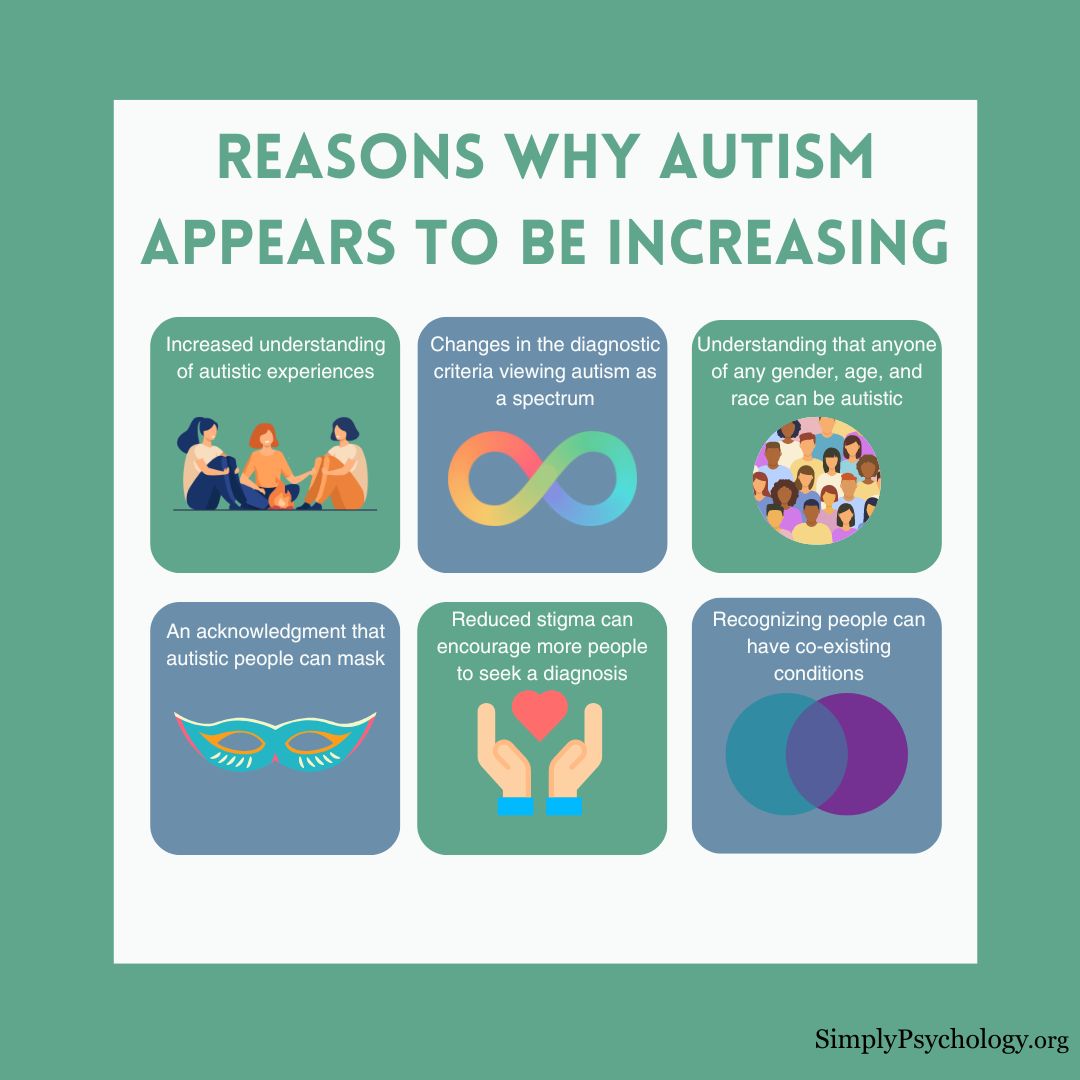Autism is a neurodevelopmental condition characterized by social interaction, communication, and behavior differences.
Autism has been the focus of increasing attention in recent years. One of the most pressing questions surrounds the prevalence rates of autism.
The Centers for Disease Control and Prevention (CDC) have reported on the number of children diagnosed as autistic since the year 2000 and have found a marked increase in prevalence (Please note these numbers come from samples from the United States only).
In 2ooo, around 1 in every 150 children had an autism diagnosis. This rose to 1 in 44 children in 2018, then to 1 in 36 children in 2020.
Additionally, the CDC reported that significantly more Black and Hispanic children and those from various socioeconomic backgrounds had received a diagnosis, whereas, in the past, White children from higher socioeconomic status would have been more likely to be diagnosed as autistic.

Due to this increase in people receiving an autism diagnosis, there is this idea that autism is somehow on the rise, and many question why this is.
Is autism really increasing, or are there other contributing factors to explain the increase in diagnoses?
This article explores the potential reasons behind the observed increase in autism prevalence rates and addresses common misconceptions about the condition.
Increased awareness
One of the biggest reasons for an increase in people diagnosed as autistic is that there is an increased understanding of autism.
This awareness may come from videos and online content from actual autistic people sharing their experiences. People may listen to these experiences and recognize similarities in traits, behaviors and challenges in themselves or loved ones. This can result in more people seeking an autism diagnosis.
My own understanding of autism was limited up until a few years ago, and it is still something I am constantly learning about. I had a narrow idea in my mind about what autism looked like, and it was not something I particularly related to.
It wasn't until I started looking into other people's experiences and hearing real autistic voices that I realized how diverse autism is and how much I actually relate to the traits. The more I increased my understanding, the more things started to click into place, and I decided to seek a diagnosis to find answers.
We also live in an age where we can easily research different conditions online – information that would have been harder to find before the internet. This ease of access to understanding autism can mean that more people know what it is and can relate to the traits.
Additionally, heightened public awareness educates parents, teachers, and caregivers about the diverse ways autism presents, enabling them to identify potential signs in children better. Consequently, they may be more likely to refer children for evaluations.
World Autism Awareness Day is a campaign on social media that has been shown to successfully increase awareness and positive sentiments about autism, according to one study.
Changes in diagnostic criteria
Advancements in diagnostic tools have led to better identification and recognition of individuals on the autism spectrum.
The most recent diagnostic criteria has been expanded to encompass more traits and differences in behavior to address how varied autism can present. This change has led to the inclusion of individuals who have lower support needs who may have previously gone undiagnosed.
For example, an individual who is able to live independently and work a full-time job can still meet the criteria for autism.
While they may not appear to have difficulties in managing most aspects of their day-to-day life, they may have differences in social situations, not be able to pick up on social cues, be sensitive to certain sensory experiences, and have restricted, repetitive patterns of behavior.
The below image, while not official, provides a useful visual for how traits of autism can vary on a personal level.

Likewise, the DSM-5 categorized autism, Asperger syndrome, and pervasive developmental disorder not otherwise specified (PDD-NOS) under a new term “autism spectrum disorder” meaning that individuals diagnosed with those previous terms, would now be deemed as autistic.
So, while it may seem that autism is more common these days, it’s important to remember that the definition of autism has changed over the decades, and there is more than one way to be autistic.
Inclusion of adults and females
In the past, autism was primarily viewed as a condition affecting boys and children, largely due to early research that focused on studying autism in these populations. This narrow understanding informed the diagnostic criteria, leading to a significant underrepresentation of autistic females and adults.
However, as our understanding of autism has evolved, it has become clear that autism affects individuals of all ages and genders. This expanded knowledge has led to an increase in diagnoses among previously overlooked populations, particularly females and adults.
Research suggests that autism may present differently in females, who are more likely to mask or camouflage their symptoms. As a result, girls and women have often been missed or misdiagnosed.
Growing up as a girl with undiagnosed autism, I always had this nagging feeling that there was something different with me that I couldn't put my finger on. I was always quiet and felt lost in social situations, which became more apparent as a teenager when girls would typically hang out in groups and socialize a lot more.
I was watching my peers 'master' social situations and wondered why it didn't come naturally to me. Realizing I am autistic as an adult has been helpful in answering many of the questions I had as a child.
Historical studies have estimated the ratio of autistic males to females to be anywhere from 2:1 to 16:1, but more recent estimates suggest a ratio closer to 3:1.
As awareness grows about how autism presents in girls and women, and as more adult women who were previously undiagnosed are now being recognized as autistic, the gender gap in autism diagnoses is likely to narrow further.
This shift in understanding and increased recognition of autism in diverse populations has contributed to an apparent increase in autism prevalence.
Acknowledgment of masking
As our understanding of autism has grown, so has our recognition of masking behaviors among autistic individuals. Masking refers to strategies used to hide or suppress autistic traits to fit in with neurotypical expectations.
This increased understanding of masking has contributed to an apparent rise in autism diagnoses, particularly among groups previously overlooked or misdiagnosed, such as girls, women, people of color, and transgender individuals.
These groups may be more likely to mask due to societal pressures and norms, leading to underdiagnosis in the past.
Additionally, autistic individuals with low support needs may be more effective at masking, leading to delayed or missed diagnoses.
Understanding what it means to mask autism is what propelled me to seek a diagnosis. I always felt like I was hyper-aware of my facial expressions and body language in social situations, often feeling like I was putting on a performance and not being myself. Hearing other people's experiences with masking felt like they were describing my life.
As professionals become better equipped to identify masking, more accurate and timely diagnoses are being made, contributing to the apparent rise in autism prevalence.
Reduced stigma
In the past, autism was often stigmatized as a disorder that burdened individuals and society. This negative perception may have led many people to feel ashamed or hesitant to seek a diagnosis.
However, the neurodiversity movement has helped shift perspectives toward acceptance and understanding of autism as a neurological difference.
As society becomes more accepting, the stigma surrounding autism has diminished, creating a more supportive environment where individuals feel comfortable seeking a diagnosis and identifying as autistic.
With reduced stigma, people are more willing to explore the possibility of being on the autism spectrum and seek professional assessments without fear of judgment.
This increased acceptance has likely contributed to the apparent rise in autism diagnoses. As more people feel comfortable seeking help and identifying as autistic, the true prevalence of autism becomes more apparent.
However, ongoing efforts are needed to promote understanding and inclusion of autistic individuals in all aspects of life.
A couple of times when I have expressed to people that I think I may be autistic (before I received a diagnosis), I have had disbelieving comments (e.g., "I really don't think you are"), or people acted as if I had told them terrible news (e.g., "Oh no! Why do you think that?"). It can feel disheartening to receive these types of comments when autism is not a death sentence.
If someone in your life tells you that they are autistic or they suspect they may be, try to hold back on judgment and sympathetic comments. You could instead say to them, “Thank you for sharing this with me. Would you like to talk about this more?”
While I think the burden should not solely be on autistic people to reduce the stigma, I personally try to be very open and honest about my autistic experiences as a way to help change the attitudes we may have about autism.
Recognizing co-existing conditions
It is worth noting that previous editions of the DSM (prior to 2013) did not allow individuals to have a diagnosis of autism and attention deficit hyperactivity disorder (ADHD) since they were considered to be opposing conditions.
Now, it is understood that there are many overlapping autistic and ADHD traits and that it is common to have both conditions.
It is unclear precisely how common it is, but a 2022 scientific literature review suggests 50-70% of autistic individuals may have co-occurring ADHD.
Because of this, there are now individuals who have ADHD who have also sought an autism diagnosis, when they would not have been able to do this before. This has possibly contributed to the increased prevalence of people being diagnosed as autistic.
Future directions
To summarize, the core reason that autism appears to be ‘increasing’ is mostly due to our understanding of autism increasing rather than the actual number of autistic people increasing.
It might just be that autism is not as rare as was once believed, and perhaps this will be reflected in future editions of the diagnostic criteria going forward.
More people are being diagnosed even well into adulthood, which suggests that autism is not a new thing. If we hear stories about our grandparents and great-grandparents that describe similar traits and experiences of autistic people, it is very possible they could have also been autistic. We just have a better understanding these days!
The increased autism prevalence has significant implications for society, highlighting the need for more resources, support services, and accommodations in schools and workplaces.
Embracing neurodiversity is crucial in accepting autism as a neurological difference rather than a disorder. This paradigm shift emphasizes the unique strengths and abilities of autistic individuals and promotes a more inclusive environment.
Early diagnosis and intervention are critical for ensuring the best outcomes for autistic individuals. Increased awareness and improved diagnostic tools allow for timely access to appropriate support, helping children develop essential skills and providing caregivers with strategies to support their child’s development.
As we move forward, raising awareness, promoting acceptance, and advocating for the rights of autistic individuals is essential. Ongoing research is crucial in furthering our understanding of autism and the most effective interventions.
By creating a more inclusive society, we can ensure that all individuals, regardless of their neurological differences, have the opportunity to thrive and contribute their unique talents to the world.
References
Ahmed, W., Bath, P. A., Sbaffi, L., & Demartini, G. (2018). Measuring the effect of public health campaigns on Twitter: the case of World Autism Awareness Day. In Transforming Digital Worlds: 13th International Conference, iConference 2018, Sheffield, UK, March 25-28, 2018, Proceedings 13 (pp. 10-16). Springer International Publishing. https://doi.org/10.1007/978-3-319-78105-1_2
Fombonne, E. (2018). The rising prevalence of autism. Journal of Child Psychology and Psychiatry, 59(7), 717-720. https://doi.org/10.1111/jcpp.12941
Hours, C., Recasens, C., & Baleyte, J. M. (2022). ASD and ADHD comorbidity: What are we talking about?. Frontiers in psychiatry, 13, 837424. https://doi.org/10.3389/fpsyt.2022.837424
Hull, L., Petrides, K. V., & Mandy, W. (2020). The female autism phenotype and camouflaging: A narrative review. Review Journal of Autism and Developmental Disorders, 7, 306-317. https://doi.org/10.1007/s40489-020-00197-9
Lai, M. C., Lombardo, M. V., Ruigrok, A. N., Chakrabarti, B., Auyeung, B., Szatmari, P., … & MRC AIMS Consortium. (2017). Quantifying and exploring camouflaging in men and women with autism. Autism, 21(6), 690-702. https://doi.org/10.1177/13623613166710
Pearson, A., & Rose, K. (2021). A conceptual analysis of autistic masking: Understanding the narrative of stigma and the illusion of choice. Autism in Adulthood, 3(1), 52-60. https://doi.org/10.1089/aut.2020.0043
Strang, J. F., Powers, M. D., Knauss, M., Sibarium, E., Leibowitz, S. F., Kenworthy, L., … & Anthony, L. G. (2018). “They thought it was an obsession”: Trajectories and perspectives of autistic transgender and gender-diverse adolescents. Journal of autism and developmental disorders, 48, 4039-4055. https://doi.org/10.1007/s10803-018-3723-6


